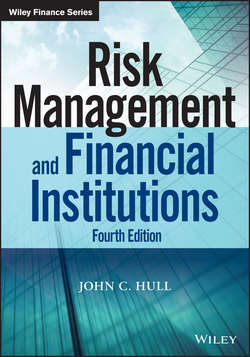Читать книгу Risk Management and Financial Institutions - Hull John C. - Страница 5
На сайте Литреса книга снята с продажи.
Preface
ОглавлениеRisk management practices and the regulation of financial institutions have continued to evolve in the past three years. Risk Management and Financial Institutions has been expanded and updated to reflect this. Like my other popular text Options, Futures, and Other Derivatives, the book is designed to be useful to practicing managers as well as college students. Those studying for GARP and PRMIA qualifications will find the book particularly helpful.
The book is appropriate for university courses in either risk management or financial institutions. It is not necessary for students to take a course on options and futures markets prior to taking a course based on this book. But if they have taken such a course, some of the material in the first nine chapters does not need to be covered.
The level of mathematical sophistication and the way material is presented have been managed carefully so that the book is accessible to as wide an audience as possible. For example, when covering copulas in Chapter 11, I present the intuition followed by a detailed numerical example; when covering maximum likelihood methods in Chapter 10 and extreme value theory in Chapter 13, I provide numerical examples and enough details for readers to develop their own Excel spreadsheets. I have also provided my own Excel spreadsheets for many applications on my website:
www-2.rotman.utoronto.ca/~hull
This is a book about risk management, so there is very little material on the valuation of derivatives. (This is the main focus of my other two books, Options, Futures, and Other Derivatives and Fundamentals of Futures and Options Markets.) The appendices at the end of the book include material that summarizes some of the valuation key results that are important in risk management, and the DerivaGem software can be downloaded from my website.
NEW MATERIAL
The fourth edition has been fully updated and contains much new material. In particular:
1. There is a new chapter comparing scenario analysis to valuation (Chapter 7). The chapter introduces the reader to the statistical processes often assumed for market variables (without any stochastic calculus), explains Monte Carlo simulation, and distinguishes between the real and risk-neutral worlds.
2. There is a new chapter on the Fundamental Review of the Trading Book (Chapter 17). This is an important new proposal from the Basel Committee.
3. There is a new chapter on margin, OTC markets, and central counterparties (CCPs) (Chapter 18). This covers recent developments in the trading of over-the-counter derivatives and introduces the reader to a number of credit risk issues.
4. There is a new chapter on enterprise risk management (Chapter 27). This discusses risk appetite, risk culture, and the importance of taking a holistic approach to risk management.
5. The sequencing of the material in the book has been improved. For example, the calculation of value at risk and expected shortfall is now covered immediately after these risk measures are introduced. The book is now divided into six parts: financial institutions and their trading, market risk, regulation, credit risk, other topics, and appendices.
6. There is more emphasis throughout the book on the use of expected shortfall. This is consistent with the Basel Committee’s plans for changing the way market risk capital is calculated (see Chapter 17).
7. The material on credit value adjustment (CVA) and debit value adjustment (DVA) has been restructured and improved (see Chapter 20).
8. A new simpler method for taking volatility changes into account in the historical simulation method is presented (Chapter 13).
9. There are many new end-of-chapter problems.
10. A great deal of software on the author's website accompanies the book.
SLIDES
Several hundred PowerPoint slides can be downloaded from my website or from the Wiley Higher Education website. Adopting instructors are welcome to adapt the slides to meet their own needs.
QUESTIONS AND PROBLEMS
End-of-chapter problems are divided into two groups: “Practice Questions and Problems” and “Further Questions.” Solutions to the former are at the end of the book. Solutions to the latter and accompanying software are available to adopting instructors from the Wiley Higher Education website.
INSTRUCTOR'S MANUAL
The instructor’s manual is made available to adopting instructors on the Wiley Higher Education website. It contains solutions to “Further Questions” (with Excel spreadsheets), notes on the teaching of each chapter, and some suggestions on course organization.
ACKNOWLEDGMENTS
Many people have played a part in the production of this book. I have benefited from interactions with many academics and practicing risk managers. I would like to thank the students in my MBA and Master of Finance risk management courses at University of Toronto, many of whom have made suggestions as to how the material could be improved.
Alan White, a colleague at the University of Toronto, deserves a special acknowledgment. Alan and I have been carrying out joint research and consulting in the area of derivatives and risk management for about 30 years. During that time we have spent countless hours discussing key issues. Many of the new ideas in this book, and many of the new ways used to explain old ideas, are as much Alan’s as mine. Alan has done most of the development work on the DerivaGem software.
Special thanks are due to many people at Wiley, particularly Evan Burton, Vincent Nordhaus, Judy Howarth, and Helen Cho for their enthusiasm, advice, and encouragement.
I welcome comments on the book from readers. My e-mail address is:
hull@rotman.utoronto.ca
JOHN HULL
Joseph L. Rotman School of Management
University of Toronto
